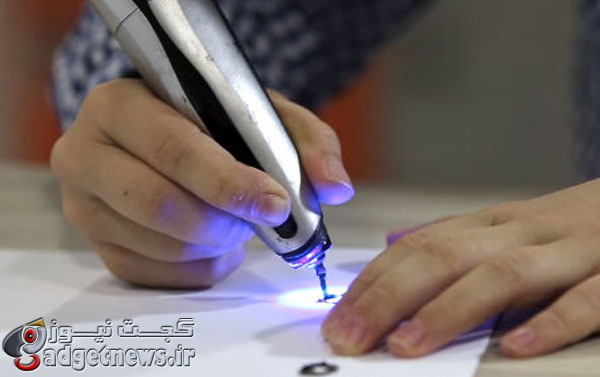
شاید شما هم قلمهای پرینت سه بعدی سبک و خوش قیافه Nix را دیده باشید. این قلمها در ظاهر بسیار جذاب و البته پرکاربرد هستند، اما هنگامی که در مورد تمامی جزئیات آن بحث کنیم، یکی از عیبهای آنها بسیار آزاردهنده است و آن گرمای تولیدی بالایی است که برای مایع شدن مرکب جامد خود به کار میبرند. این قلمها در بهترین حالت ممکن مرکبی 80 درجه سانتیگرادی تولید میکنند که این درجه گاه به عدد 150 نیز میرسد.
اما حالا یک پروژه جدید در سایت جذب حمایت مالی Indiegogo از یک راه حل جدید در تولید این قلم ها استفاده کرده است. قلم CreoPop از نور ماوراء بنفش برای ترسیم اشکال استفاده میکند.
CreoPop به جای استفاده از گرما که میتواند گاه باعث سوختگیهای شدیدی در بدن انسان شود، از سه باریکه نور ماوراء بنفش در اطراف نازل قلم استفاده میکند تا به شکل مداوم مایع خروجی سرد از قلم را به جامد تبدیل کند. از این طریق تمامی خطرات حاصل از گرمای این قلمهای پرینت سه بعدی از بین میروند و آن را حتی برای کودکان نیز بی خطر میکند.
حتی در تئوری طرحهایی تمیزتر و بدون بوی زننده پلاستیک مایع میتوان ایجاد کرد.البته قلمهای پرینت سه بعدی در نوع خود نیازمند تمرین بسیار نیز هستند. وقتی پرینترهای سه بعدی بزرگ را تصور کنید، تمامی مراحل پرینت توسط خود دستگاه و در یک فضای کاملا کنترل شده اتفاق میافتد. اما در قلمهای پرینت سه بعدی تمام این اعمال به خود فرد واگذار میشود. وجود چنین قلمی در این موارد کاربرد خود را بیشتر نشان میدهد.
CreoPop در صورت دریافت کمکهای مالی مورد نیاز قرار است با قیمت ارزان 89 دلار به فروش برسند که البته بسیار ارزان تر از قلمهای Nix محسوب میشوند. از تمام خوبیهای این قلم که بگذریم اما استفاده از آن بدون محافظ نیز ممکن است باعث بروز بیماریهایی برای انسان شود. اما حداقل ایده ای جالب حتی برای دستگاههای سه بعدی بزرگ به نظر میرسد.
نظر شما خوانندگان گجت نيوز در باره اين قلم چيست؟
منبع : gizmodo
A 3D Printing Pen That Uses UV Light Instead of Dangerous Heat
If you've ever used a hot glue gun for a craft project, you already know how tricky and messy they can be to work with. And this is partly why the handful of 3D printing pens already on the market aren't the easiest tools to use. So maybe the CreoPop pen, which instead uses UV light to cure a liquid resin, might be a better solution.
Many 3D printers, including the pens you've already seen hitting Kickstarter and Indiegogo, melt and extrude a solid plastic that quickly solidifies again as it cools. With a desktop 3D printer, a computer-controlled printhead ensures the stream of molten liquid plastic being extruded is highly-controlled. With a handheld pen, that's all left to the user, often leading to wispy strands of plastic being left behind until you master a specific technique.
In other words, they work, but require a lot of patience, practice, and skill to produce something recognizable and worthwhile.
Instead of using heat, which also has the potential of causing some serious skin burns, the CreoPop uses a set of three ultraviolet lights surrounding the nozzle that instantly harden a light-sensitive liquid resin as it's being extruded. The risk of burns is completely eliminated, making the pen safe for kids to use. And, at least in theory, it makes it easier to produce cleaner looking models since there are no runaway strands of melted plastic all over the place.
There are some disadvantages to the CreoPop pen, though. As 3D printers become more and more popular, the strands of meltable plastic they use as a source material becomes easier to find, and cheaper to buy. The CreoPop instead uses its own proprietary cartridges that cost around two to three bucks each and can produce a 46-foot line of hardened plastic. So like with an inkjet printer, you're stuck buying the company's own refills.
On the flip side, just like with inkjet printers, that means the CreoPop pen hardware will sell for a relatively cheap $89. Or, more specifically, will require an $89 pledge since the handheld 3D printer is starting life on the crowdfunding site Indiegogo. So there's a chance it may never actually see the light of day if it doesn't meet its funding goals. But as these devices are becoming more and more popular, the chance to buy one that's easier and safer to use will be hard for hobbyists to pass up. [CreoPop via Cnet]
 گجت نیوز آخرین اخبار تکنولوژی، علم و خودرو
گجت نیوز آخرین اخبار تکنولوژی، علم و خودرو 





